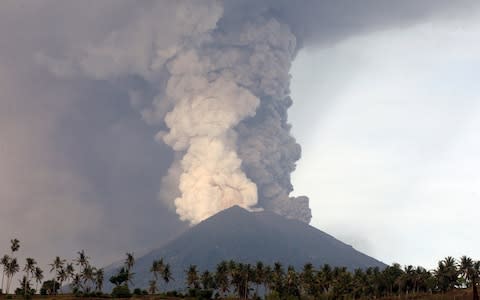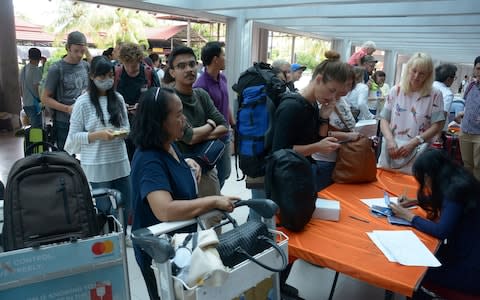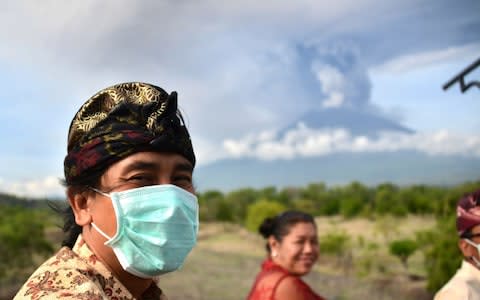Bali volcano: Mount Agung closes airport for second day, leaving British tourists in limbo

Almost 60,000 tourists were stuck in holiday limbo on Tuesday as an "imminent" eruption on the island of Bali saw more than 440 flights cancelled for a second day.
The panic began at the weekend when Mount Agung spurted clouds of grey and white ash across the Indonesian island and sparked a dangerous flow of debris, prompting fears it was on the verge of its first major eruption in more than 50 years.
As the ash clouds reached heights of almost 10,000 feet, with glowing magma visible at the peak, 40,000 people were evacuated from the surrounding area.
Disaster agency workers said that a total of 100,000 people would need to be evacuated, while officials warned the island was on "maximum alert."
"The Volcanic Ash Advisory shows that the plane routes have been covered by volcanic ash, this is dangerous for the flights," Wisnu Darjono from the air traffic agency AirNav official said, referring to a global network of experts that supplies volcano-related information.
Mount Agung eruption in Bali causes travel chaos, in pictures
One British tourist said he had been close to the volcano on Monday.
"I was up there, maybe just 1km (from the summit)," Daniel Constable told the Telegraph. "It was empty, I know about it (active volcano), I just didn't realise that it's that dangerous. I heard it rumble, I got scared and I turned away."
The 26-year-old life guard from Manchester said he had been on the island for a week.
"I am supposed to fly with Qatar to Doha today then to Manchester. I went to the Qatar desk, they are just trying to get everybody out," he said at the airport.

"They suggest I take the bus to Surabaya then to Jakarta, where they will fly me out to Doha. I am not going to do that. I am going to wait it out till Thursday, the last minute. I don't have anything urgent back home, just work (on Thursday)."
Arie Ahsan, a spokesman for the airport, said 443 flights were cancelled on Tuesday, affecting 59,539 passengers.
Experts said that Agung's recent activity matches the build-up to the 1963 eruption, which killed some 1,600 people.
That eruption ejected enough debris - about a billion tonnes - to lower global average temperatures by 0.2 - 0.3 degrees Celsius for about a year.

"What we are seeing at the moment are small explosions, throwing out hot gases and fragments of molten rock, or ash," said David Pyle, a volcano expert at Oxford University.
"The probability of a large eruption is high, but this may take some days or weeks to unfold."
There were long lines at airline desks at the airport, with many passengers expressing frustration that they hadn't been given clear answers on what to do.
With no indication of when the airport may reopen, travellers were being advised either to take a 9-hour bus journey to Surabaya and then then try to catch a flight there, or to go directly to Jakarta - which would be a 24 hour bus trip.
Sarah Murphy, 40, and Tina Lucke, 31, were among the British tourists caught up in the chaos.
After their Emirates flight to London Gatwick via Dubai was cancelled on Monday, they were re-booked onto the next available flight on Tuesday - only for that flight to be grounded after the airport was closed for another 24 hours.
The pair, who arrived on Bali on November 16, are staying in Padang Padang and are not near the volcano.
"I have spoken with quite a few tourists who are in similar positions," Ms Murphy said. "Some people staying here now were in Ubud and were apparently told to get over this side of the island because if it (the volcano) blows, then Ubud will be impossible to get out of because it's so busy with traffic.

"Some other tourists I spoke to couldn't get hold of their airlines so had no idea what was happening or when or how they would leave."
Janeen McKay, who was anxious to get back to western Australia where she cares for her 80-year-old mother, told The Telegraph she arrived at the airport around 8am on Monday.
"We didn't know anything about the cancellation. My other sister is now caring for her so my sister and me can have some holiday here. I just need to go home."
She added: "We didn't know anything about free accommodation, we heard nothing. I am 51 years old; it's not comfortable to sleep on the hard floor."
"I am not worrying so much for me about the eruption, but I do feel for the locals who lost their homes. For me, it's just the flight delay," she added.
In a twist of irony, 31-year-old German tourist Noémi Galas said she been assured by a tour guide that there was no risk of Mount Agung erupting during a visit to another volcano nearby.
"I went to to Mount Batur and saw the crater. My guide told me that there was another volcano that is actually active at the moment," she told The Telegraph.
At a glance | Deadliest volcanos
"He said don't worry, nothing will happen, it won't erupt. Now I am here."
"It was actually my friend who told me that my flight was cancelled, I didn't know anything. I checked in yesterday online, all was fine. I checked the website there was nothing. So I came here."
Indonesia's disaster mitigation agency said the volcano’s eruptions were magmatic, meaning that lava has been forced to the surface. Blasts from the volcano were heard miles away.
An agency spokesman said evacuation orders have been issued but some residents had refused to flee because they felt safe or wanted to tend to their livestock.
"We really ask people in the danger zone to evacuate immediately because there's a potential for a bigger eruption," said a spokesman for the agency.

“Authorities will comb the area to persuade them. If needed we will forcibly evacuate them.”
Bali, an island lined with beaches and lush jungles and rainforests, is the most popular tourist destination in Indonesia and attracts about five million visitors a year. More than 220,000 British tourists visited last year.
Indonesian authorities arranged bus transport for tourists stranded at Bali’s airport on Monday and organised a free night’s accommodation. Many of the stranded tourists were expected to leave the island by ferry.
“We now have to find a hotel and spend more of our money that they're not going to cover us for when we get home unfortunately," Brandon Olsen, a Canadian tourist stranded at the airport with his girlfriend, told Associated Press.
Volcano Agung's eruption hazards
Video footage showed large trails of volcanic mud – or lahars – running down the hillside. These can collect debris and rocks which can destroy houses and roads.
Mount Agung, in eastern Bali, has been threatening to erupt for some time, prompting an evacuation of 140,000 people in September. The alert was lowered on October 29 as the activity decreased but was raised again three weeks later.
Indonesia’s Vulcanology and Geological Disaster Mitigation Centre told Reuters the northeast area of Mount Agung’s peak has swollen in recent weeks “indicating there is fairly strong pressure toward the surface”. It said that a large eruption could send rocks bigger than fists up to five miles away and volcanic gas to a distance of six miles within three minutes.
